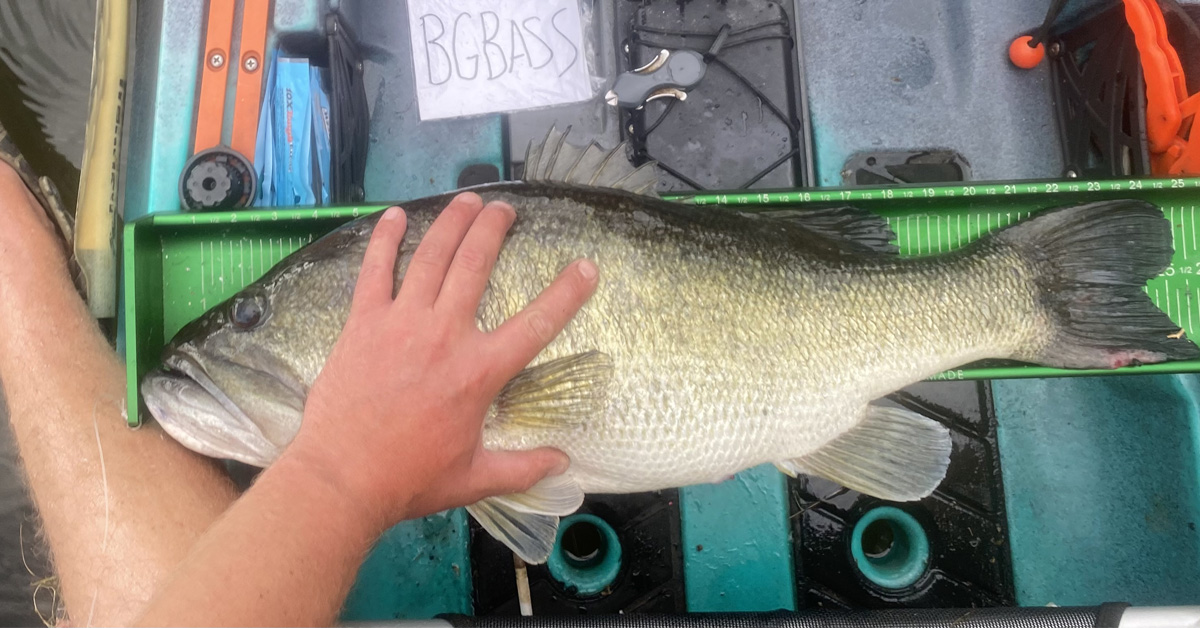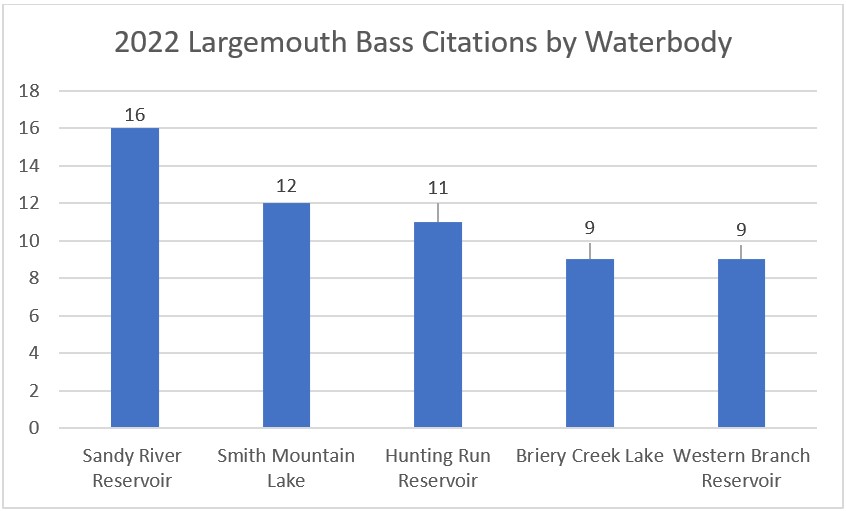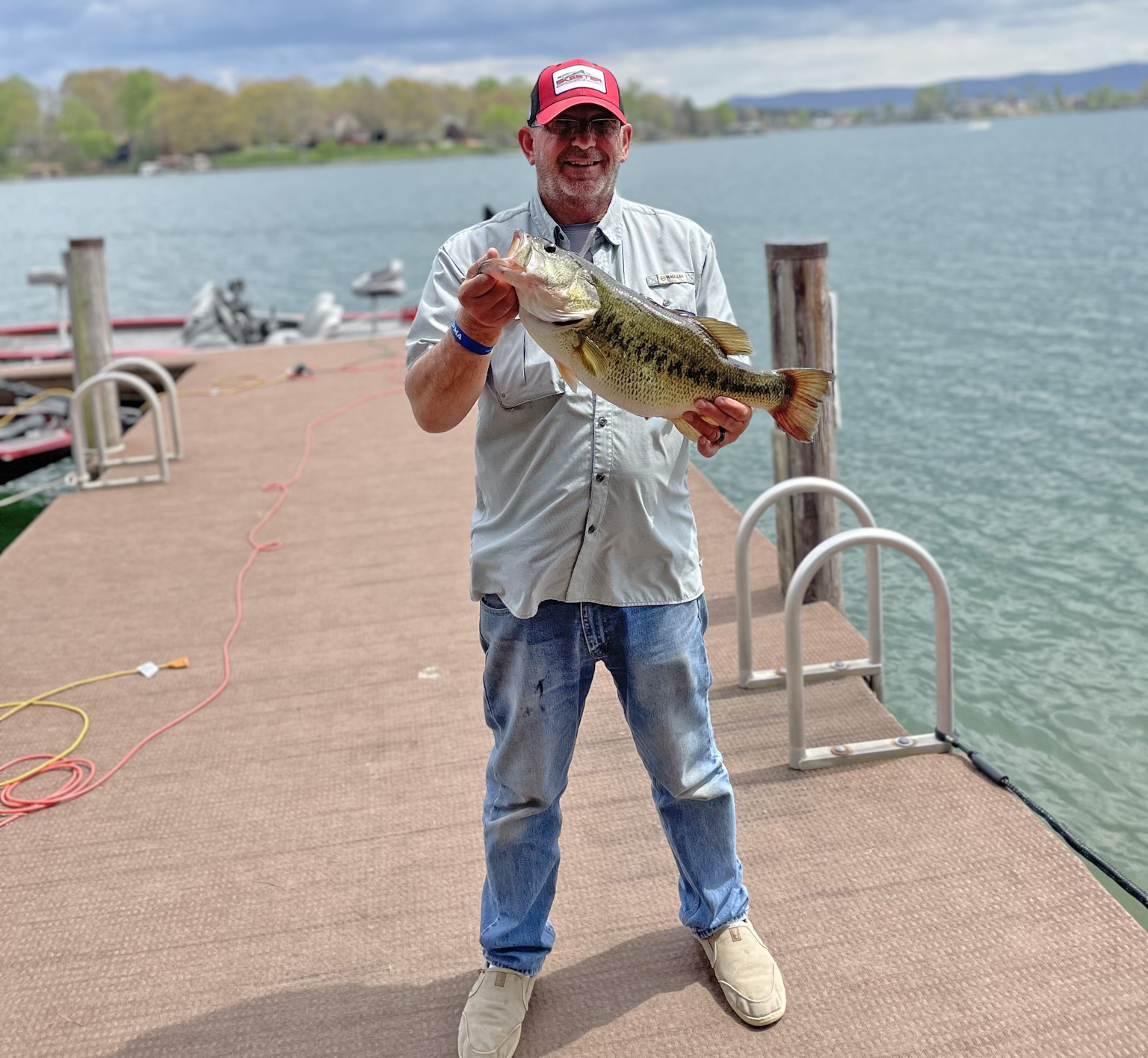
Francis Peterson recorded this 25.5" largemouth into the Virginia Online Angler Recognition Program after catching it in Briery Creek Lake.
By Alex McCrickard/DWR
The Virginia Department of Wildlife Resources (DWR) is tasked with managing freshwater fisheries across the state of Virginia using best available science. Our biologists utilize a variety of fisheries methodology to collect information on the health of our fisheries. Data derived from scientific fisheries methodology is known as fishery-independent data and is key to managing our fisheries for the best interest of the public. Examples of fishery-independent surveys include electrofishing, gill netting, and trap netting surveys that our biologists implement to manage these public resources. Additionally, angler-derived data or fishery-dependent data is data that is collected from recreational and or commercial sources. Fishery-dependent data can also play a role in the management of our fisheries.
The Online Virginia Angler Recognition Program (OVARP) is one unique source of fisheries-dependent data that our agency collects annually. The OVARP is a voluntary program where anglers can be recognized for the catch of trophy-sized freshwater fish. Different minimum lengths and weights are required to reach trophy “citation” size for the 30 different species in the program. Of particular interest to Virginia anglers are the numbers of citation largemouth bass and smallmouth bass that are caught annually.
Largemouth bass must be a minimum of 22″ to be a length citation and 8 pounds to be a weight citation. Smallmouth bass must be a minimum of 20″ to be a length citation and 5 pounds to be a weight citation. You can receive a citation for either length or weight—or both—but we are talking about truly large specimens for both species here! Below are the lists of the top five waterbodies by total numbers of bass citations from 2022 for largemouth bass. (Stay tuned next month for the same information about smallmouth bass.) It should be noted that this is a voluntary program based on the honor system. Not every citation caught in Virginia is entered into the program, so this is simply a reflection of the data collected from the past year within OVARP.
The top five waterbodies rated by total numbers of largemouth bass citations caught in 2022:

- Sandy River Reservoir produced 16 citation largemouth bass in 2022, giving this impoundment the #1 ranking as the location for citations last year. Sandy River Reservoir is a 740-acre water supply impoundment located in Prince Edward County just east of Farmville. With construction completed in 1994, this relatively new impoundment is a scenic resource nestled in the rolling hills of Virginia’s Piedmont. A variety of habitats support a robust largemouth bass population, including standing timber, submerged aquatic vegetation, stumps, downed trees, flats, and drop-offs. “Sandy River Reservoir offers largemouth anglers a unique combination of high catch rates and the opportunity to catch quality fish,” said Hunter Hatcher, DWR fisheries biologist. “Citation records from 2022 reveal what many in central and southside Virginia have known for years. Sandy is a big bass factory worthy of every bit the acclaim its sister lake, Briery Creek, just down the road receives.”
- Smith Mountain Lake might be best known for its trophy striped bass fishery, but anglers searching for trophy largemouth bass should not overlook this top destination. Smith Mountain Lake ranked #2 for citation largemouth with 12 being caught in 2022. This scenic impoundment is large, at 20,600 acres, and located in Bedford and Franklin counties. Smith Mountain Lake provides deeper water habitat in addition to rock shoals, submerged brush piles, fallen trees, DWR habitat structures, coves, and numerous big points. In the spring, anglers can target boat docks and piers (just remember to be courteous to local landowners). Smith Mountain is one of the large impoundments involved in DWR’s F1 largemouth bass program, which is aimed at enhancing the quality of largemouth bass fisheries in Virginia. “DWR electrofishing catch rates in 2022 for largemouth bass eight inches and larger were the highest recorded since the current sampling protocol was established in 2000,” said Dan Wilson, DWR fisheries biologist. “Additionally, the numbers of larger bass increased to the highest levels in 2018 and has remained stable through 2022.”

Samuel Johnson caught this 23.75″ largemouth from Smith Mountain Lake in 2022 and submitted it to the Virginia Online Angler Recognition Program.
- Hunting Run Reservoir, located in Spotsylvania County, is a 420-acre water supply reservoir that has been open to the public since 2007. This impoundment produced 11 citation largemouth bass catches in 2022, giving it the #3 spot in the top five waterbodies ranking. Anglers should note that they need to have an access permit from Spotsylvania County to fish this reservoir. This is a good destination for anglers to chase largemouth bass, as DWR sampling has shown an increasing trend in catch rates over the last few years. In addition to chances at trophy bass, anglers will find an abundance of two- to three-pound fish on this smaller impoundment. “The reservoir always had a plethora of good habitat, including copious standing timber and contractor-created brush piles, but the fishery was predator-heavy from the beginning,” said John Odenkirk, DWR fisheries biologist. “Through multiple remedial stockings of various forage species (and removal of small bass for several early years), this bass population is now reaching its full potential, and Hunting Run can be regarded as a legitimate trophy destination.”
- Briery Creek Lake is located within DWR’s Briery Creek Wildlife Management Area in Prince Edward County. This 845-acre lake has long been popular amongst anglers targeting trophy largemouth bass, and nine citations were caught here in 2022. Regulations on Briery Creek help to support this trophy fishery with a protective slot of 16-24″. Bag limits are still five fish per day, but only one can be above 24 inches. Springtime is the best time of year to chase trophy largemouth bass on Briery Creek. “Even though Briery Creek may be a shadow of its former self, which challenged the largemouth bass state record in the early 2000s, the lake continues to turn out trophy size fish at a respectable rate relative to other lakes around the commonwealth,” said Hunter Hatcher, DWR fisheries biologist. “Briery offers anglers a challenge with abundant standing timber that makes every inch of the lake look fishy. For best success, take note of forage activity and target creek channels and other areas with distinct depth changes.”
- Located in Suffolk, Virginia, the 1,265-acre Western Branch Reservoir is the largest of Norfolk’s water-supply lakes. Anglers should be aware that the city of Norfolk does require a boat permit for fishing this lake. Nine citation largemouth bass were caught in Western Branch Reservoir in 2022, giving it a place in the top five list for numbers of citation bass. This lake not only provides anglers with opportunities to target trophy largemouth bass, but also produces lots of two- to four-pound fish. Additionally, every year Western Branch produces lots of citation-sized redear sunfish, which is an added bonus for anglers looking for a diverse fishing experience. Late winter into early spring provides anglers the best opportunity at tangling with a truly big largemouth bass at Western Branch.
Alex McCrickard is DWR’s Angling Education Coordinator. Check out his Fishing Reports on YouTube!


